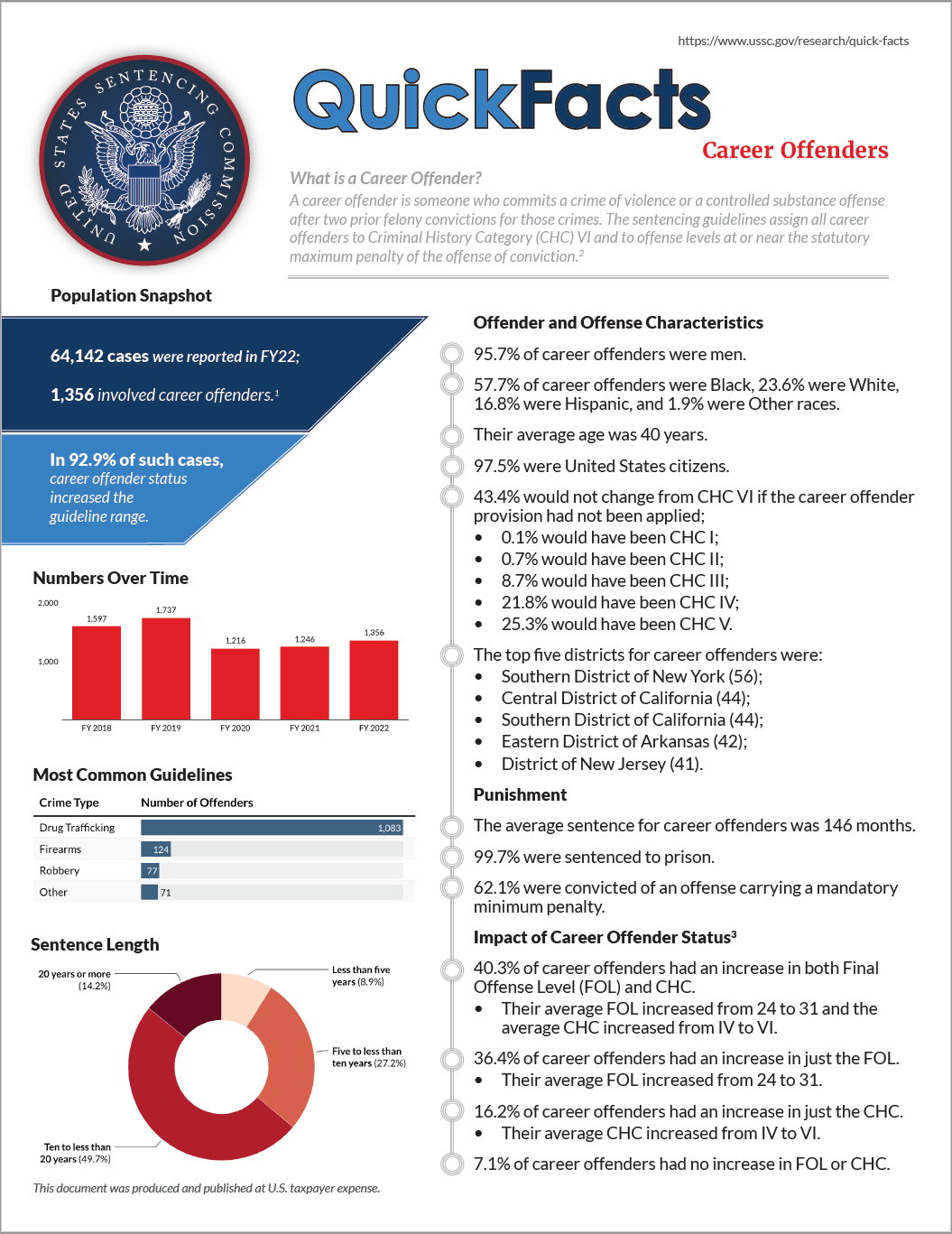Of the 61,678 cases reported to the Commission in fiscal year 2024, 1,280 involved career offenders.1 In 93.0% of such cases, career offender status increased the guideline range.
Click the cover for the PDF handout or learn more below.
What is a Career Offender?
A career offender is someone who commits a crime of violence or a controlled substance offense after two prior felony convictions for those crimes. The sentencing guidelines assign all career offenders to Criminal History Category (CHC) VI and to offense levels at or near the statutory maximum penalty of the offense of conviction.2
Individual and Offense Characteristics
- 96.1% of career offenders were men.
- 59.1% were Black, 22.8% were White, 16.0% were Hispanic, and 2.1% were Other races.
- Their average age was 41 years.
- 99.2% were United States citizens.
- 40.8% remained in Criminal History Category (CHC) VI after the career offender provision was applied;
- 0.0% changed from CHC I to CHC VI;
- 1.5% changed from CHC II to CHC VI;
- 13.5% changed from CHC III to CHC VI;
- 19.7% changed from CHC IV to CHC VI;
- 24.5% changed from CHC V to CHC VI.
- The top five districts for career offenders were:
- District of New Jersey (68);
- Eastern District of Arkansas (50);
- Eastern District of Missouri (42);
- Western District of Missouri (40);
- Middle District of Pennsylvania (36).
Punishment
- The average sentence for career offenders was 154 months.
- 99.6% were sentenced to prison.
- 60.7% were convicted of an offense carrying a mandatory minimum penalty.
Impact of Career Offender Status
- 40.6% of career offenders had an increase in both Final Offense Level (FOL) and CHC.3
- Their average FOL increased from 25 to 31 and their average CHC increased from IV to VI.
- 33.8% had an increase in the FOL only.
- Their average FOL increased from 25 to 31.
- 18.6% had an increase in the CHC only.
- Their average CHC increased from IV to VI.
- 7.0% of career offenders had no increase in FOL or CHC.
Sentences Relative to the Guideline Range
- 40.2% of sentences for career offenders were under the Guidelines Manual.
- 17.9% were within the guideline range.
- 17.6% were substantial assistance departures.
- The average sentence reduction was 47.3%.
- The average sentence reduction was 47.3%.
- 0.4% were Early Disposition Program (EDP) departures.4
- The average sentence reduction was 52.3%.
- The average sentence reduction was 52.3%.
- 4.3% were some other downward departure.
- The average sentence reduction was 51.0%.
- 17.9% were within the guideline range.
- 59.8% of sentences for career offenders were variances.
- 59.1% were downward variances.
- Their average sentence reduction was 37.7%.
- Their average sentence reduction was 37.7%.
- 0.6% were upward variances.
- Their average sentence increase was 25.9%.
- 59.1% were downward variances.
- The average guideline minimum has increased while the average sentence imposed has fluctuated over the past five years.
- The average guideline minimum increased from 220 months in fiscal year 2020 to 226 months in fiscal year 2024.
- The average sentence imposed was 150 months in fiscal year 2020 and 154 months in fiscal year 2024.
- The average guideline minimum increased from 220 months in fiscal year 2020 to 226 months in fiscal year 2024.
1 Cases with incomplete sentencing information were excluded from the analysis.
2 In some cases, a state offense classified under state law as a misdemeanor (e.g., in Iowa, Massachusetts, and Michigan) is considered a felony in determining "career offender" status. For more information, see USSG §4B1.1.
3 Cases missing Ch. 2 guideline data and cases in which §4B1.1(c) applied were excluded for this part of the analysis. Cases where both §4B1.1 and §4B1.4 (Armed Career Criminal) applied were assigned to the provision with the higher offense level.
4 “Early Disposition Program" (or EDP) departures are departures where the government sought a sentence below the guideline range because the defendant participated in the government’s Early Disposition Program, through which cases are resolved in an expedited manner. See USSG §5K3.1.
SOURCE: United States Sentencing Commission, FY 2020 through FY 2024 Datafiles, USSCFY20-USSCFY24.

